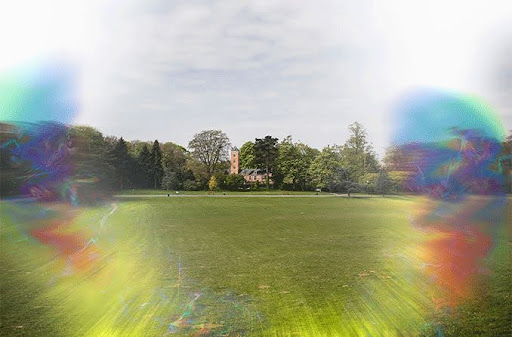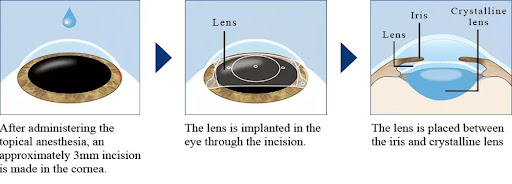Scintillating Scotoma, though an unusual term, is a distressing visual experience characterized by shimmering, flickering, or flashing patterns in one’s vision field. It is like having a temporary light show inside your eye. Without professional treatment, this eye condition can be disorienting and lead to temporary visual impairment, making everyday tasks much harder.
Scintillating scotoma may seem like a hopeless visual concern, but hope exists. Our team of experts at Eyeonce Eye Clinic, headed by Dr. Paik Dong Won and Dr. Jung Sae Rom, is dedicated to guiding you through understanding, managing, and finding practical solutions for this eye condition.
Causes and Risk Factors
Scintillating scotoma is often associated with migraines that manifest as shimmering, flashing, or zigzagging patterns in a person’s field of vision. Some of its causes and risk factors are the following:
Causes
- Migraine with aura – One of the most common causes of scintillating scotoma is its association with migraine headaches. It often serves as a visual aura preceding the onset of a migraine headache. Migraines are believed to involve changes in the blood flow and brain chemistry, which can affect the visual cortex and trigger scintillating scotoma.
- Cortical Spreading Depression – Scintillating scotoma may occur due to a phenomenon called Cortical Spreading Depression (CSD), characterized by a wave of abnormal brain activity that spreads slowly across the visual cortex, leading to visual disturbances.
- Vascular issues – Changes in blood vessels, particularly those supplying the brain and eyes, can contribute to scintillating scotoma. Narrowing of blood vessels followed by widening may directly affect blood flow in the visual pathways, leading to visual disturbances.
- Genetic factors – There is evidence suggesting that genetics may play a role in the development of migraines, which, in turn, can lead to scintillating scotoma.
- Hormonal fluctuations – Hormonal changes, especially in women, can influence the occurrence of migraines and scintillating scotoma. Some women experience these visual disturbances concerning their menstrual cycle or hormonal contraceptives.
Risk Factors
- Personal history of migraines
- Family history
- Gender
- Age
- Hormonal factors
- Stress and lifestyle
- Dehydration
- Environmental factors
- Certain medications
- Underlying health conditions
If you or someone you know is at risk of developing scintillating scotoma, consult our ophthalmologists at Eyeonce Eye Clinic to identify potential triggers, develop effective management strategies, and provide targeted care for this eye condition.
Symptoms
Scintillating scotoma’s symptoms may vary in their presentation by typically following a specific pattern such as:
- Shimmering and flickering – The most prominent symptom of scintillating scotoma is the perception of shimmering or flickering lights. These lights often appear as small, bright, sparkling dots or lines.
- Zigzagging patterns – Another common symptom is zigzagging or wavy lines within the visual field. These lines may appear in a crescent shape and gradually expand, creating a zigzagging effect.
- Crescent or C-shaped visual disturbance – A scintillating scotoma often starts as a small crescent-shaped area of visual disturbance, typically near the center of the visual field. This area then expands and moves outward.
- Blind spot – During a scintillating scotoma episode, individuals may experience a temporary blind spot in their vision. This blind spot corresponds to the area where the shimmering or zigzagging pattern is present.
- Distorted vision – Objects or texts within the affected area of the visual field may appear distorted or blurred. It can make it challenging to see clearly and can be disorienting.
- Flashing or sparkling lights – Some people describe the lights in scintillating scotoma as flashing or sparkling. These lights may change in intensity and color as they move across the visual field.
- Visual disruption – Scintillating scotoma can disrupt normal vision, making it difficult to focus on tasks or objects within the affected area. This disruption can be temporary but can cause momentary visual discomfort.
- Duration – Scintillating scotoma episodes typically last relatively short, ranging from 20 minutes to an hour. While the symptoms can be alarming, they are usually self-limiting and gradually resolve.
- Visual aura preceding migraine – This aura can be a warning sign, alerting individuals that a headache may follow.
It is important to note that scintillating scotoma is a temporary phenomenon, and while it can be unsettling, it is not typically associated with pain or long-term vision loss. However, visiting a trusted eye center, such as Eyeonce Eye Clinic in Gangnam, Seoul, South Korea, is highly advisable for proper treatment and guidance.
Treatment Options
Lifestyle modification
Our ophthalmologists at Eyeonce strictly recommend our patients recognize and avoid triggers that may precipitate migraines and scintillating scotoma. These triggers include stress, certain foods such as caffeine, alcohol, irregular sleep patterns, etc.
Medications
In some cases, our eye doctors at Eyeonce may recommend over-the-counter pain relievers, such as ibuprofen and aspirin, to help alleviate the headache that can accompany scintillating scotoma. They may also prescribe prescription medications designed to treat migraines that can effectively prevent or reduce the frequency and severity of visual auras. In cases where scintillating scotoma is frequent and disruptive, our eye doctors may recommend preventive medications such as beta-blockers, calcium channel blockers, and antiepileptic drugs.
Consultation and Monitoring
Eyeonce Eye Clinic offers comprehensive eye examinations to ensure no underlying eye conditions contribute to visual disturbances. For individuals experiencing severe or persistent scintillating scotoma, our eye care professionals may provide a tailored evaluation and treatment plan that best suits your needs.
Why choose Eyeonce Eye Clinic Gangnam for eye scintillating scotoma treatment?
Utmost Patient Care
Our eye care professionals and staff ensure to give you your money’s worth. We guarantee you receive the best medication possible and assure you that you are guided and understood, making you feel comfortable and confident at every step.
Comprehensive Consultation
Eyeonce Eye Clinic offers comprehensive eye examinations to evaluate your condition and determine the best eye strain treatment. Our ophthalmologists take their time to cater to your questions and address your concerns, ensuring you make an informed decision about our vision correction options.
Expert Eye Doctors
Our ophthalmologists, Head Director Dr. Paik Dong Won and Medical Director Dr. Jung Sae Rom, are highly knowledgeable and adept in treating eye strain. They always use the latest techniques and technologies to ensure optimal results.
Frequently Asked Questions (FAQs)
Scintillating scotoma is often triggered by migraine aura, which results from temporary changes in brain activity. Other causes include stress, dehydration, and dietary factors
While it may not always be preventable, identifying and avoiding personal triggers can reduce the frequency of scintillating scotoma episodes.
In most cases, scintillating scotoma is harmless; however, if you experience this phenomenon for the first time or notice unusual changes in your vision, consult an eye doctor immediately.
Conclusion
While scintillating scotoma can temporarily disrupt the visual world, understanding its origins, triggers, and management options empowers us to navigate this eye condition confidently. With the help of expert eye specialists and eye centers like Eyeonce Eye Clinic, you will surely regain clearer vision. Book an appointment with us today!



